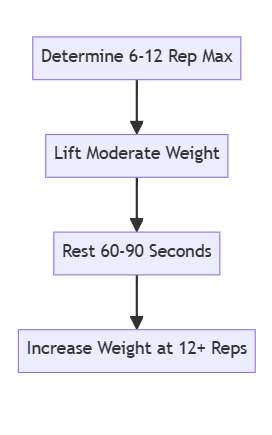
💥 Hypertrophy workout routines can increase muscle size by up to 60% and double strength, based on these research-backed recommendations
🌟 Staying in shape and building muscle can be challenging. At Health Waggle, we analyze the latest studies from the past few months; however, if nothing highly impactful has been published recently, we refer to earlier studies such as The Mechanisms of Muscle Hypertrophy and Their Application to Resistance Training to provide insights you can trust.
Published in the Journal of Strength and Conditioning Research, this comprehensive study confirms several factors that regulate hypertrophy (the enlargement of muscle cells):
- Mechanical tension from lifting heavy weights
- Metabolic stress from “the burn”
- Muscle damage from microtears
- Cell signaling that kickstarts growth
- Hormonal spikes during training
Strategically incorporating these stimuli can turn on muscle growth.
Researchers have studied the best ways to structure strength training programs to maximize growth and strength gains.
Their findings provide insight into how muscles grow in response to exercise and how to optimize your workout routine.
🧩 Key Terms Explained
- Strength training: Lifting weights to build muscle and strength. Also called resistance training.
- Hypertrophy: The enlargement of muscle fibers in response to strength training, leading to muscle growth.
- Muscle tension: The force generated when a muscle contracts against resistance. This tension triggers muscle growth.
- Metabolic stress: The buildup of metabolites like lactate during exercise. This contributes to muscle fatigue and growth.
📈 Recommendation
Perform 6-12 reps per set with 60-90 sec rest between sets to optimize muscle tension and metabolic stress.
This maximizes muscle growth.
🎓 Findings
- Strength training causes muscle fibers to grow larger (hypertrophy). This increases muscle size and strength.
- Muscle tension during lifting triggers muscle growth. Moderate loads (6-12 reps) build more tension than light (1-5) or heavy loads (15+).
- Metabolic stress from lactic acid buildup also signals growth. Shorter rest periods (60-90 sec) increase metabolic stress.
- Combining moderate tension and metabolic stress maximizes hypertrophy. Gains of up to 60% in muscle size are possible.
- Training to failure enhances muscle activation and metabolic stress but increased injury risk if overdone. Periodize it. Or check out this insight and tip for a safer approach How Many Sets You Need for Optimal Muscle Growth – Health Waggle
- Multi-joint and single-joint exercises complement each other. Include both multi-joint and isolation exercises and vary them to fully stimulate all muscle fibers.
🧠 Why It Works
- Moderate tension (6-12 reps) fatigues all muscle fiber types for maximum growth across the muscle.
- Metabolic stress from short rest periods boosts anabolic hormones and cell swelling, further stimulating growth.
This approach provides an ideal blend of mechanical tension, metabolic stress, and muscle damage to activate muscle growth signaling pathways like mTOR, MAPK, calcineurin, and IGF-1.
✋ Limitations
In summary, medium reps with progressive volume optimize mechanical tension on muscle fibers, metabolic buildup, muscle damage, and anabolic hormone responses – all of which signal your body to synthesize more muscle proteins.
- Findings may not apply to trained weightlifters who need heavier loads to continually challenge muscles.
- Genetics affect individuals’ potential for muscle growth regardless of training method. The findings may not apply as well to trained athletes or the elderly.
🌍 Examples
- Many bodybuilders successfully use moderate load, short rest period routines to maximize muscular hypertrophy.
- The “hitting the reps sweet spot” approach is commonly recommended by trainers for building mass.
⚡ Steps to Implement
- Determine your 6-12 rep max for each exercise.
- Perform 2-5 sets of each exercise, using a weight you can lift 6-12 times before failure.
- Rest 60-90 seconds between sets to allow partial recovery.
- Increase weight when you can exceed 12 reps to stay in the hypertrophy range.

Behind the Research
🔬 Study type: Literature review synthesizing findings from over 200 studies related to muscle growth mechanisms and strength training variables.
🔗 Link to the original research paper: https://journals.lww.com/nsca-jscr/Fulltext/2010/10000/The_Mechanisms_of_Muscle_Hypertrophy_and_Their.40.aspx
👩🔬👨🔬 Authors of the discovery: Brad J. Schoenfeld
❓ FAQs
Q1: How much can I increase my muscle mass from this routine?
- Research shows strength training can increase muscle size by 50-60% over time if nutrition supports muscle growth. Results vary based on genetics, diet, consistency, etc.
- For beginners, up to 2 lbs of muscle per month is common in the first year. With proper nutrition and progression, an experienced lifter might gain 10 lbs of muscle in a year.
Q2: Were biases present in selecting the research reviewed?
- The author aimed to provide an unbiased review of current exercise science literature. He included research supporting varying conclusions.
Q3: What should I eat to maximize muscle growth from training?
- Eat enough protein (0.5-0.8 g per lb of body weight daily) along with a slight calorie surplus (10-20% above maintenance).
Q4: How do moderate rep ranges build more muscle than low or high reps?
- Moderate reps generate enough tension to fatigue all fiber types. Lower reps mainly target slow-twitch fibers. Higher reps use insufficient load.
Q5: What other types of exercise can I do to build muscle?
- Compound lifts, bodyweight exercises, plyometrics, and sprints can all help build muscle when combined with proper strength training.
Q6: Will this routine work for women too?
- Yes, the fundamental principles apply equally. However, women produce less testosterone, so very high volumes may be excessive.
📚 References
Schoenfeld, B. J. (2010). The mechanisms of muscle hypertrophy and their application to resistance training. Journal of Strength and Conditioning Research, 24(10), 2857-2872.
🌟 Final Note
Implementing a well-structured strength training program can lead to impressive muscle growth over time. Let me know if you have any other questions about optimizing your workouts for maximum hypertrophy! I’m always happy to help break down the science into actionable insights.
🔍 Study Summary Table
| Finding | What It Means for Hypertrophy |
|---|---|
| Moderate loads more effective than light or heavy loads | 6-12 rep range optimizes mechanical tension and metabolic stress for growth across all fiber types |
| Short rest periods enhance hormonal response | 60-90 sec rest intervals heighten metabolic stress, increasing anabolic hormones and cell swelling that promote growth |
| Multi-joint and single-joint exercises have benefits | Multi-joint moves maximize muscle activation; single-joint moves allow isolation and prevent imbalances |
| Eccentric emphasis enhances mechanical tension | Lowering weights slowly enhances mechanical tension on muscles, sparking greater growth response |
| Exercise rotation important | Varying exercises activates all aspects of a muscle; frequent exercise rotation prevents accommodation to a movement |
| Periodized progressive overload critical | Gradual increase in volume/intensity over time maximizes gains; brief overreaching phases followed by taper can spur accelerated growth via supercompensation |







